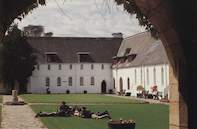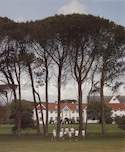Maynier's Cottage
Before the end of the first year of the school’s inception, three more pupils, including a day boy - Bishop Gray's own son, Charles - had been enrolled and the school was receiving applications for the following year's admission. Maynier's Cottage was already becoming too small.

Maynier's Cottage served the Bishop's school for just one year. As the first term of 1850 opened, the boys moved into the Woodlands farm buildings.
The main house served as the principal's residence and dormitory for the boarders, outbuildings were used as classrooms, and the stable became the chapel.
But by the second term at Woodlands 22 pupils were enrolled, the college was again becoming seriously overcrowded and Mr Canon White (the headmaster), pressing for a new school building, enlisted the professional help of his architect brother William, in England.
New School Premises
The Reverend George Ogilvie was a 35-year-old bachelor clergyman blessed with the tough determination of his Scottish ancestry. He gave up his post after less than three years as headmaster of St George's Grammar School in Cape Town to take up the challenge at Bishops. It was indicative of his personality that when he became principal of Bishops in 1861 the number of pupils was increased to 59 by his very presence - 27 boys from his former school came with him.
Under his leadership, new school buildings were erected: a classroom, dining hall and kitchen. His energy rejuvenated the flagging Woodlands spirit. Under his direction Bishops bounced back and began to register academic and sporting achievements. One of the early changes that the sporting Canon made was to introduce to the Woodlands sports field the game known as 'Winchester rules', the handling football game that had developed in English public schools and in due course evolved into the rugby of today.
In the academic field, meanwhile, Bishops' particular success was lauded in 1867 when Ogilvie was able to announce that the school had been the only one in which two pupils had scored firsts in the Cape Colony's School Examination. In honour of the occasion, he said, the Diocesan College School would henceforth be known simply as the Diocesan College.
The years to 1900 were a period of consolidation during which the junior school amalgamated with the Anglican grammar school, St Saviours, and moved briefly to the Claremont estate of Feldhausen, once the home of the famed astronomer, Sir John Herschel, and bought by Archbishop West Jones as a personal gift to the school.
Expansion

George Ogilvie's successor, Reverend JE Sedgwick, resigned after an unhappy year at Bishops and the man who stepped into the breach was Richard Brooke, who had established St Saviours and became warden of the amalgamated Diocesan junior school at Feldhausen before being persuaded to take over as principal of the upper school at Rondebosch. The juniors moved back to Bishops in 1901 when the estate of Feldhausen was sold to help finance expansion of the Rondebosch school complex.
A new cricket field — the Frank Reid Field of today - was laid out. The school governors embarked on an energetic fund-raising programme and, helped again by international church funds, it was decided to build from scratch and create virtually a new school on the Rondebosch site.
Back in 1882, after having completed his apprenticeship as an architect, the young Herbert Baker had come out to the Cape in order to oversee his younger brother Lionel's use of the family money in a fruit-farming venture. While walking on Devil's Peak one morning, Baker had encountered Cecil John Rhodes out for an early ride; a short discourse led to a dinner invitation for the young architect, and later to the job of renovating Rhodes's home at Groote Schuur, which helped to established Baker as a leading architect of his time.
It seems almost inevitable that Herbert Baker, with his close relationship to Rhodes (whose influence on Bishops was significant) and his preeminence among South African architects, should have had a hand in the growth of Bishops. It was he who in 1896 was asked to draw up plans to extend the Bishops prep school and to add a physics laboratory. In June 1900, the foundation stone of School House was formally laid.
And finally, in 1901, when Rhodes was sick and ailing and had begun to think about the transfer of his ambitions to the generations that would succeed him, it was to the boys of Bishops that he turned.
Rhodes had planned to attend the benediction of the new school buildings in January 1901, but he was too sick and was advised by his doctor to stay at home. Instead he sent a letter to Archbishop West Jones, asking if the school could be made 'the subject of an experiment in a gift for competition by the school boys'. In essence Rhodes's offer was a donation of £250 a year for a three-year scholarship to Oxford University in England.